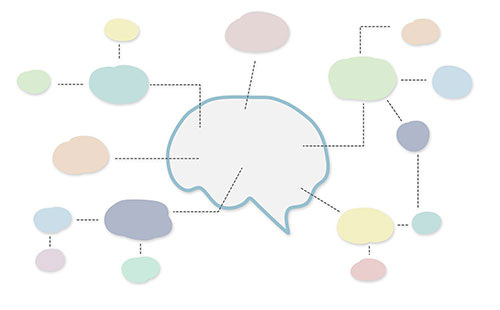Learning Principle N°3: The ability to follow thoughts carefully and control one’s attention are prerequisites for learning.

Article by Dr Karen L. Taylor, Director of Education and of the Institute of Learning and Teaching, Ecolint
I once had a student, let’s call her Daisy, who would sit on the windowsill in the classroom during the lesson and knit. She was a very creative thinker and an excellent knitter; she was not a particularly strong student academically. In faculty meetings, some of her teachers would complain that Daisy was inattentive, even disrespectful. I will put the question of respect aside because I think that has more to do with the individual teacher than with Daisy. The thing is that Daisy could only concentrate on what was going on in a lesson when she knitted. Moreover, she knew this about herself and so she persisted even when she met with resistance from adults. These days we would say that Daisy possessed a degree of metacognitive awareness. And a good dose of strong will.
So what exactly is attention and why is it important?
We often talk about student engagement. Many researchers refer to the importance of active engagement for learning. However, attention and engagement may look different depending on the student. We might even be mistaken in judging student engagement. A student might be looking out the window at a bird in the tree next to the school building (or knitting) and paying attention, while another student who appears to be looking at you and nodding is not. When we think of engagement we should be thinking about cognitive engagement (Tokuhama-Espinosa, 2014).
One of the challenges of teaching is to capture students’ attention when they enter the classroom and to keep it. Which means being aware of attention span and cycles of attention in relation to the rhythm of the lesson. We may think, then, about attention in terms of duration but also in terms of concentration. The aim is to create an environment in which student attention is sustained and focused to enhance learning.
Executive functioning and self-management skills allow our brains to filter information in order to concentrate on what is important and to avoid distractions. As William James wrote as long ago as 1890, attention “implies withdrawal from some things in order to deal effectively with others.” As teachers, we can help students by being explicit. We can be careful to set clear learning objectives and set up tasks and activities so as to avoid cognitive overload. In this way we facilitate our students’ capacity to select and classify information, to identify key concepts, to be attentive to what is important and to remember it.
Attention and memory are linked. There are ways in which we can structure our teaching to facilitate the embedding of knowledge in students’ long-term memory. Rote memorization is not the purpose of education. At the same time, memorizing information can be important for establishing foundational knowledge that can then be used for higher order thinking and reasoning. When the context and medium of instruction vary, students have more cues to draw from for retrieval (Kang, 2016).
Practice makes perfect as the old adage goes. Not only practice but also the timing and spacing of practice. Practice and repetition help us to assimilate knowledge that we store in our long-term memory. Spaced repetition of content and interleaving (sequences of content to which one returns in a pattern) promote long-term retention of knowledge and contribute to problem-solving and the transfer of knowledge from one domain to another. (Kang, 2016).
Stanislas Dehaene refers to a helpful and natural cycle in our brains: prediction, feedback, correction, new prediction (Dehaine, 2013). Errors derived from experience are essential to learning as is, perhaps ironically, forgetting. De Bruyckere (2018) reminds us of the Ebbinghaus forgetting curve (1885): “content that has been learnt, forgotten, and then learned again becomes more quickly and more firmly re-established in the memory” (p. 52). The challenge is the long-term planning that facilitates student attention as focus. Concept-based learning in a spiral curriculum, whereby key concepts are repeated with deepening layers of complexity in multiple contexts, may provide the means. So, too, does collaboration with teachers in other disciplines so that the repetition of concepts takes place not only in our own classroom but across the curriculum.
Things to consider:
- Do my students demonstrate involvement in their learning (engagement can be intellectual, social and/or physical)?
- Am I aware of cycles of attention and interest in students’ thinking?
- Do we use learning opportunities to develop new understanding and opportunities for creative problem-solving?
Suggested Reading
- Bruyckere, P. D. (2018). The ingredients for great teaching. SAGE.
- Chanquoy, L., Tricot, A., & Sweller, J. (2007). La charge cognitive: Théorie et applications. Armand Colin.
- Dehaene, S. (2013). Les quatre piliers de l’apprentissage, ou ce que nous disent les neurosciences. Paris Tech Review. http://www.paristechreview.com/2013/11/07/apprentissage-neurosciences/.
- James, W. (1890). The principles of psychology, by William James. Holt.
- Kang, S. H. (2016). Spaced Repetition Promotes Efficient and Effective Learning. Policy Insights from the Behavioral and Brain Sciences, 3(1), 12-19. doi:10.1177/2372732215624708
- Musial, Manuel, et al. (2012) Comment Concevoir Un Enseignement? De Boeck.
- Sherrington, T. (2020). Rosenshine’s Principles in Action. John Catt Educational.
- Tokuhama-Espinosa, T. (2014). Making classrooms better: 50 practical applications of mind, brain, and education science. W.W. Norton & Company.
- Tokuhama-Espinosa, T. (2011). Mind, brain, and education science: A comprehensive guide to the new brain-based teaching. W.W. Norton.

